Bulle
Count

Before I met my Sardinian boyfriend I had never ever heard about the nuraghes, or about the civilization that built them. Now that I do know about them, and have actually seen a bunch of nuraghes, both small and big, I wonder why we don't hear about it. The Nuragic civilization started in the Bronze age and is named from the characteristic buildings of the nuraghes. Today around 7,000 nuraghes still exists in Sardinia, some with really high towers originally going up to 26-30 meters.



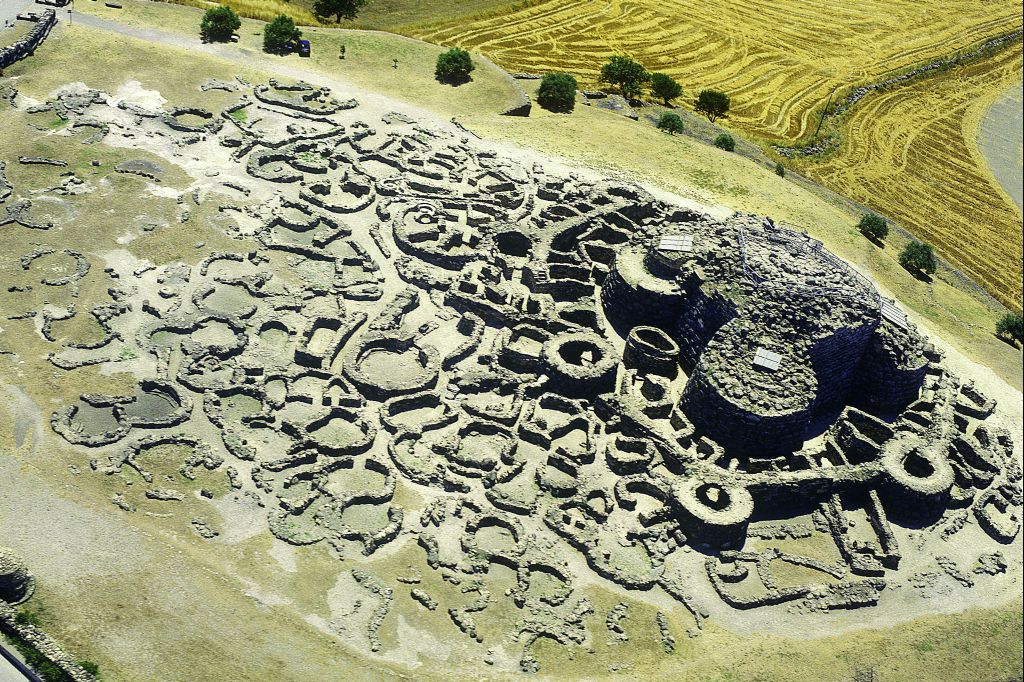

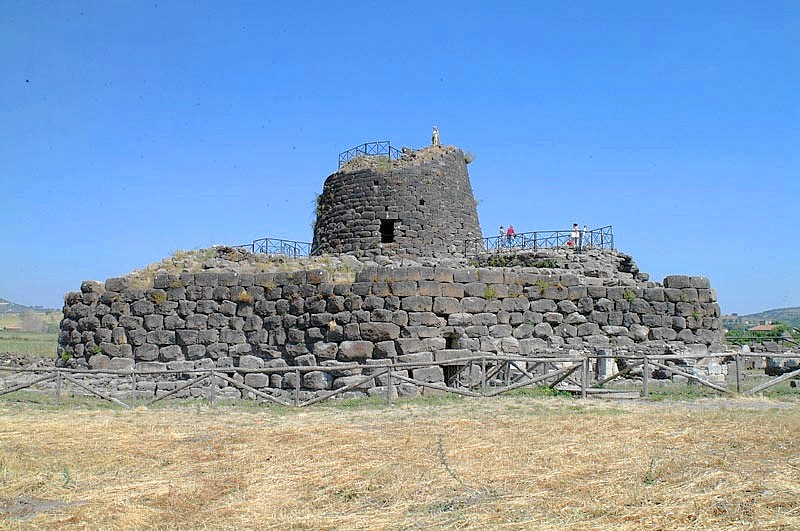

The ceiling of a nuraghe:

Due to the fact that there is not much archeological digging at all, thanks to the Italy that is trying to oppress the Sardinian people in all ways, on of them by taking away their history, there is not much that people knows about the Nuragic civilization. According to the book The Nuragic Civilization by Paolo Melis, these are the few things that we know:
The origins of the nuragic peoples did not come from abroad but were the indigenous Sardinians who had in previous ages (the Neolithic and Chalcolithic) created the great prenuragic cultures and who now, following the social and economic transformations made possible by the discovery and use of metals, especially bronze, had evolved towards more complex forms of social organization which led to the creation of an original form of architecture: it is the period of which in Western and Mediterranean Europe is known as 'proto-history'. The nuragic civilization proper began developing in the final period of the so-called 'Bonnannaro Phase', the cultural aspect of the earliest Bronze Age mostly characterized by the development of megalithic graves, Tomba di giganti or giants tomb. The first phase, known as Nuragic I (1700-1500 BC), saw the emerging of the main features of this civilization; between the end of the Early Bronze Age and the beginning of the Middle Bronce age the first proto-nuraghi were built. The proto-nuraghi differ from the classical ones: more squat and with irregular floor plans, and they do not possess the large circular chamber that is typical of nuraghi.
It is stated that the nuraghi are not present in any other area in the Mediterranean, exept for more or less far-removed cousins like the Mycenaean tholoi or the Corsican torre, the talajots of the Balearic Isles, the Sesi of Pantelleria, the Brochs of Scotland and so on. These are usually more simpler constructions and are even later then the nuraghi - perhaps with the sole exception of the Corsican torre that was most probable inspired by the nuraghe.
Every nuragic community conducted its life within the confines of its own cantonal lands, which was guarded and defended by a closeknit system of nuraghi against the raids or perhaps expension of neighbouring tribes. However, relations with other groups must have been fairly close, not only because of issues connencted with trade and the circulation of goods (especially metals), but also for religious reasons with so called sanctuary villages.
Except for the nuraghi, which were used by a few hegemonic families within the community in the case of the more or less large and important fortresses, most nuragic people lived in the villages of more or less simple and numerous huts: in some cases up to several hundred, but the very few settlements excavated up to now (Su Nuraxi and Barumini to mention two) gives us the erroneous idea that they were of fairly modest size owing to the partial nature of the excavations and the total destruction of large areas over the centuries. The huts were modest dwellings made of stone with a roof usually made of trunks and branches. The walls inside were often plastered with mud or clay and sometimes insulated with cork. During the final stages of the Nuragic cilivization these huts developed into a more sophisticated type of hut.
Within the villages, the huts are arranged haphazardly and no large public square or any sort of common area has ever been found. At most there could have been a sort of 'patio' for the dwellings of a single family group or clan. No streets, common wells or springs, no watering throughs or gutters have been found, except those belonging to the final stage. In some villages they had a common pen, perhaps used for trading.
The only 'public' buildings in the villages were the nuraghi themselves and the so-called meeting huts which were used for meetings in the community or with the chiefs or neughbouring tribes, and where in general important decisions concerning the community were made.
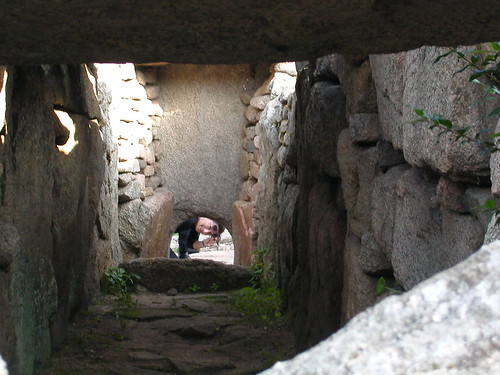

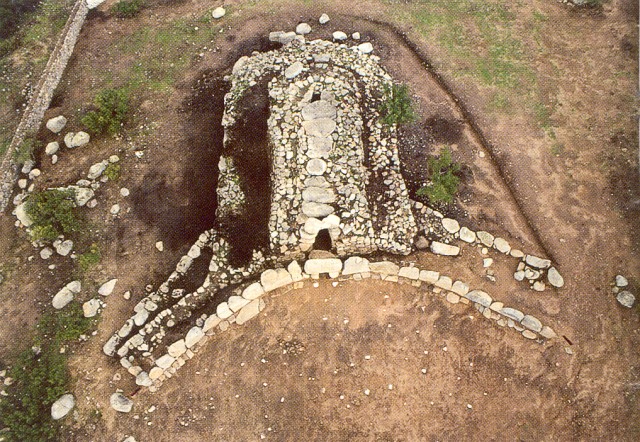
The nuragic religion was the cult of the dead and beliefs connected with life. The religious architecture is represented mostly by sacred wells and springs: constructions connected with the animistic cult of water. The water was venerated mostly as a precious liquid flowing from Mother Earth, the mother of all living creatures, no longer portrayed in the form of a woman as in prenuragic times, but still strongly present in the beliefs or nuragic peoples. Another mention of this female divinity, creator and wet nurse, can be seen in the betyls with mammalian bosses. Around the temples they usually hade so called sacred villages, in these places there were religious celebrations that lasted several days and, under the aegis of the divinity of the sanctuary, the different tribes, putting aside for the moment their disputes and resentments, met for religious celebrations, but also to reach important political agreements and exchange goods.



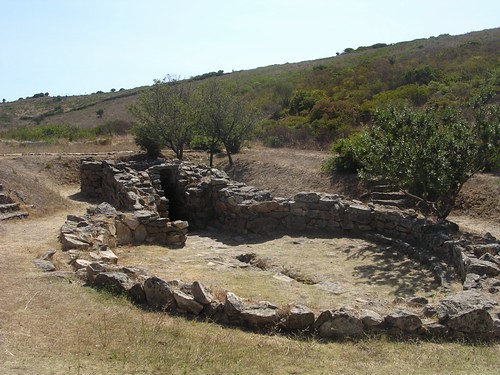
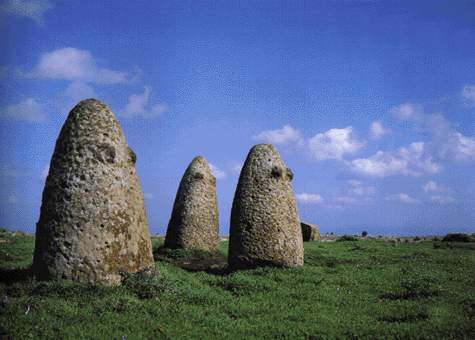
The nuragic civilization made different bronze and stone statuettes, designs on pottery, and bread stamps. The bronze statuettes are usually made in order to sacrifice, either for thanking or wishing, giving courage infor certian ordeals. The statuettes shows both men and women, which is a sign that women did have a good position in society, it is also speculated that the women had a religious role. Also boats are depicted, and it is believed that the nuragic were seafaring people, perhaps even the infamous so called sea people or Shardana.



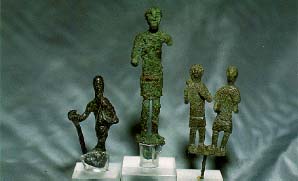


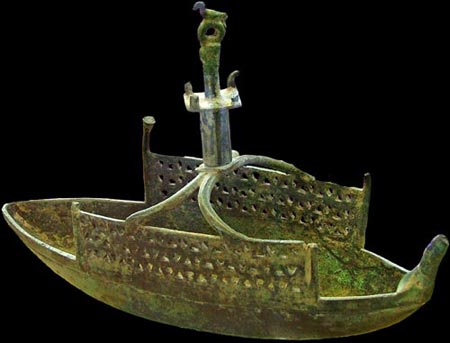
How come you never hear about the Nuragic civilization? Have you heard about it before?






The ceiling of a nuraghe:

Due to the fact that there is not much archeological digging at all, thanks to the Italy that is trying to oppress the Sardinian people in all ways, on of them by taking away their history, there is not much that people knows about the Nuragic civilization. According to the book The Nuragic Civilization by Paolo Melis, these are the few things that we know:
The origins of the nuragic peoples did not come from abroad but were the indigenous Sardinians who had in previous ages (the Neolithic and Chalcolithic) created the great prenuragic cultures and who now, following the social and economic transformations made possible by the discovery and use of metals, especially bronze, had evolved towards more complex forms of social organization which led to the creation of an original form of architecture: it is the period of which in Western and Mediterranean Europe is known as 'proto-history'. The nuragic civilization proper began developing in the final period of the so-called 'Bonnannaro Phase', the cultural aspect of the earliest Bronze Age mostly characterized by the development of megalithic graves, Tomba di giganti or giants tomb. The first phase, known as Nuragic I (1700-1500 BC), saw the emerging of the main features of this civilization; between the end of the Early Bronze Age and the beginning of the Middle Bronce age the first proto-nuraghi were built. The proto-nuraghi differ from the classical ones: more squat and with irregular floor plans, and they do not possess the large circular chamber that is typical of nuraghi.
It is stated that the nuraghi are not present in any other area in the Mediterranean, exept for more or less far-removed cousins like the Mycenaean tholoi or the Corsican torre, the talajots of the Balearic Isles, the Sesi of Pantelleria, the Brochs of Scotland and so on. These are usually more simpler constructions and are even later then the nuraghi - perhaps with the sole exception of the Corsican torre that was most probable inspired by the nuraghe.
Every nuragic community conducted its life within the confines of its own cantonal lands, which was guarded and defended by a closeknit system of nuraghi against the raids or perhaps expension of neighbouring tribes. However, relations with other groups must have been fairly close, not only because of issues connencted with trade and the circulation of goods (especially metals), but also for religious reasons with so called sanctuary villages.
Except for the nuraghi, which were used by a few hegemonic families within the community in the case of the more or less large and important fortresses, most nuragic people lived in the villages of more or less simple and numerous huts: in some cases up to several hundred, but the very few settlements excavated up to now (Su Nuraxi and Barumini to mention two) gives us the erroneous idea that they were of fairly modest size owing to the partial nature of the excavations and the total destruction of large areas over the centuries. The huts were modest dwellings made of stone with a roof usually made of trunks and branches. The walls inside were often plastered with mud or clay and sometimes insulated with cork. During the final stages of the Nuragic cilivization these huts developed into a more sophisticated type of hut.
Within the villages, the huts are arranged haphazardly and no large public square or any sort of common area has ever been found. At most there could have been a sort of 'patio' for the dwellings of a single family group or clan. No streets, common wells or springs, no watering throughs or gutters have been found, except those belonging to the final stage. In some villages they had a common pen, perhaps used for trading.
The only 'public' buildings in the villages were the nuraghi themselves and the so-called meeting huts which were used for meetings in the community or with the chiefs or neughbouring tribes, and where in general important decisions concerning the community were made.



The nuragic religion was the cult of the dead and beliefs connected with life. The religious architecture is represented mostly by sacred wells and springs: constructions connected with the animistic cult of water. The water was venerated mostly as a precious liquid flowing from Mother Earth, the mother of all living creatures, no longer portrayed in the form of a woman as in prenuragic times, but still strongly present in the beliefs or nuragic peoples. Another mention of this female divinity, creator and wet nurse, can be seen in the betyls with mammalian bosses. Around the temples they usually hade so called sacred villages, in these places there were religious celebrations that lasted several days and, under the aegis of the divinity of the sanctuary, the different tribes, putting aside for the moment their disputes and resentments, met for religious celebrations, but also to reach important political agreements and exchange goods.





The nuragic civilization made different bronze and stone statuettes, designs on pottery, and bread stamps. The bronze statuettes are usually made in order to sacrifice, either for thanking or wishing, giving courage infor certian ordeals. The statuettes shows both men and women, which is a sign that women did have a good position in society, it is also speculated that the women had a religious role. Also boats are depicted, and it is believed that the nuragic were seafaring people, perhaps even the infamous so called sea people or Shardana.






How come you never hear about the Nuragic civilization? Have you heard about it before?













